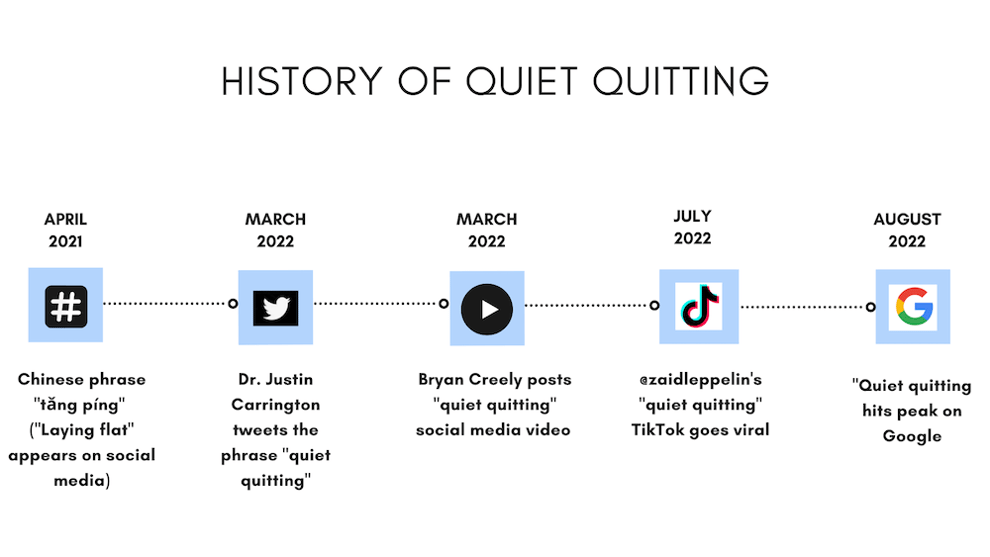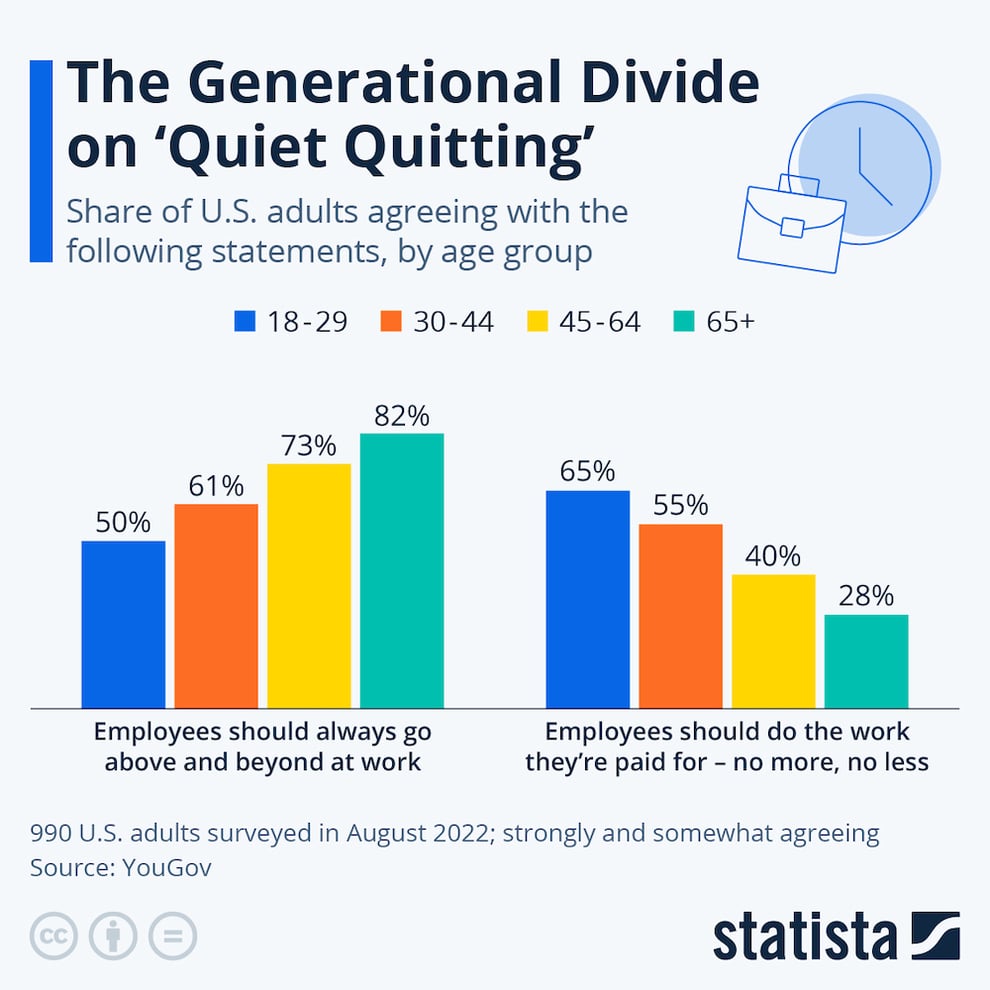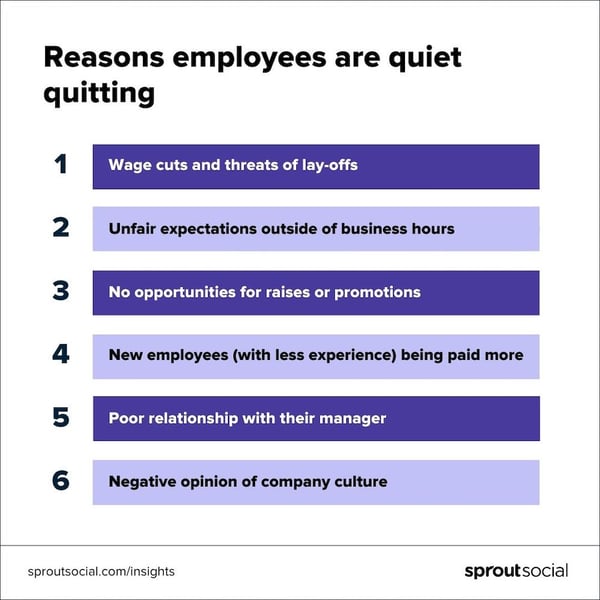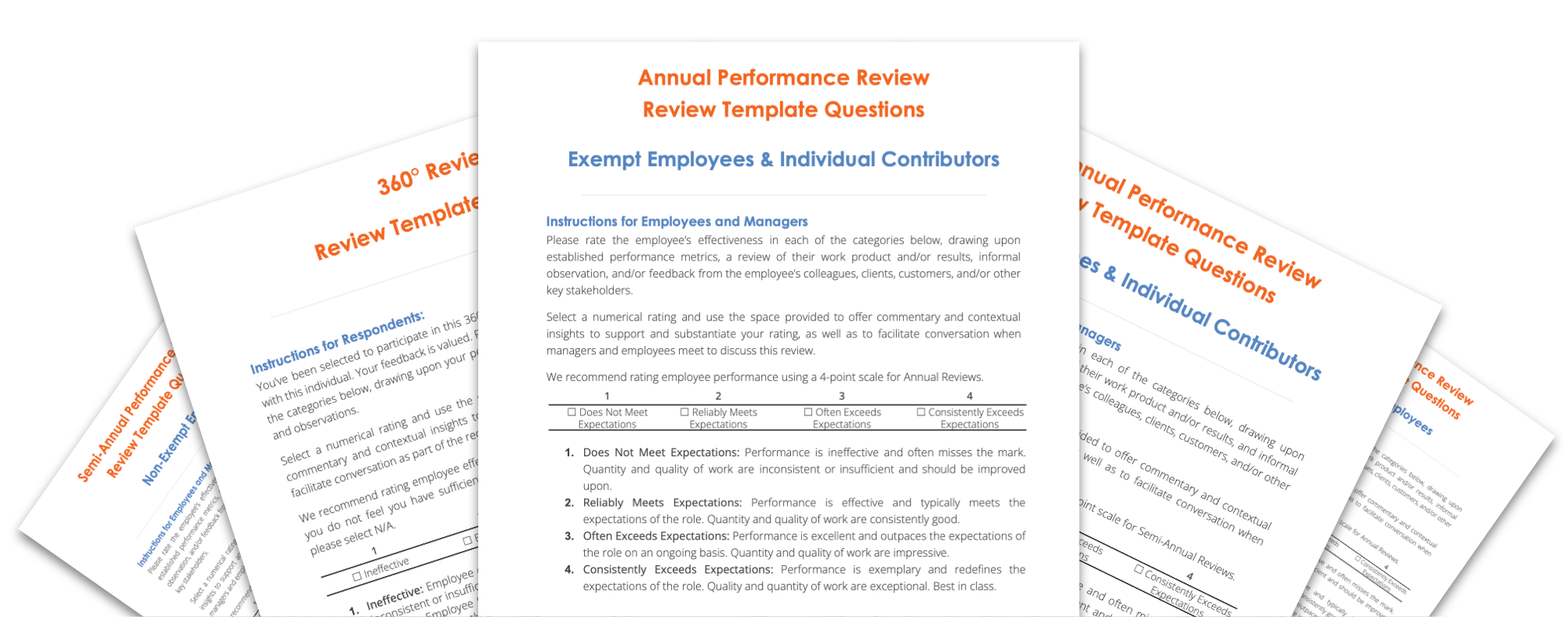Quiet quitting — have you heard of it?
Despite the name, it’s not actually about employees quitting their jobs. Quiet quitting refers to when employees stop going above and beyond at work. According to Gallup research, at least 50% of the workforce is made up of quiet quitters.
In the wake of the Great Resignation and amid a hot labor market, it’s important to address quiet quitting among your workforce. In this article, we’ll cover everything your business needs to know about quiet quitting, including ways to prevent it.
What is Quiet Quitting?
Quiet quitting is a trend that recently went viral on social media referring to when employees just fulfill their job requirements at work — nothing more or less.
Doing the bare minimum points to a lack of engagement at work. In practice, this can look like employees who are not:
- contributing to meetings
- canceling or avoiding manager one-on-ones
- being fully present in the workplace
- attending non-mandatory meetings
- volunteering for or seeking out work that isn’t in their job description
- getting involved with the rest of the team or avoiding social events

Why are People Quiet Quitting?
“Managers need to be better listeners, coaches, and collaborators. Great managers help colleagues learn and grow, recognize their colleagues for doing great work, and make them truly feel cared about. In environments like this, workers thrive.” - via Gallup
Establishing reasons why employees leave is crucial to determining if your business has a quiet quitting problem.
Read on to learn some of the main reasons employees might turn to quiet quitting.
1. Lack of Support
Employees are more likely to engage in quiet quitting when they feel that their managers cannot advocate for them.
When managers are unaware of support issues in the workplace or are ineffective when dealing with them, their employees don’t typically approach them when they’re unhappy.

2. Excessive Workloads
Quiet quitters are often employees who experienced burnout due to excessive workloads.
Whether that’s due to picking up extra work when colleagues leave, a general increase in work, or a competitive workplace atmosphere, managers who don’t scale back workloads can find themselves in a quiet quitting culture.
3. Unclear Expectations
Unrealistic or unclear expectations can wreak havoc with your employees’ well-being. Employees who find themselves with extra responsibilities outside of their job roles or working in an entirely different role are prime candidates for quiet quitting.
When managers don’t set goals or give feedback, employees can’t know how they’re performing. That can cause poor performance, stress, and ultimately quiet quitting.

Why is Quiet Quitting a Problem?
Quiet quitting negatively impacts businesses. It’s impossible to maintain high productivity rates, secure growth, and ensure success with a disengaged workforce.
As a trend, quiet quitting is problematic because it indicates a fundamental problem between your business and employees in terms of expectations. Quiet quitting does not mean that employees don’t want to go above and beyond — it means that employees lack confidence in their employer to either compensate them appropriately for their work or to moderate their workloads.
Over time, quiet quitting chips away at the relationships between your business and employees and damages company culture.
How to Spot Quiet Quitting
Luckily, there’s plenty you can do to spot signs of quiet quitting in your workplace before it becomes a problem.
1. Create Employee Engagement Surveys
Sending regular employee engagement surveys to your workforce can help identify if there are any feelings of disengagement. Be sure to act on this feedback to maintain trust with your employees.
2. Monitor Productivity Metrics
If you have employees who are engaged in quiet quitting, chances are your productivity rates are dropping. Monitoring your business’s productivity metrics is helpful for establishing a baseline that you can track over time.
Quiet quitting can look like employees who stop striving once they hit monthly quotas or fail to speak up in meetings unless directly addressed. This kind of behavior change is indicative of either the start of quiet quitting or another issue that you need to know about.

3. Check Internal Promotion Rates
New opportunities or promotions don’t tend to come the way of employees that are quiet quitting. Checking the employees who are not up for promotions (or those who show a lack of interest in promotions) can help you to identify quiet quitters.
4. Intuition
If you get the feeling that something isn’t quite right with your employees, listen to your intuition and check in with them. It can work against quiet quitting among your workforce — and it’s a good practice in general.
If you spot signs of quiet quitting, it’s essential that you implement strategic HR management to tackle the problem.
How to Prevent Quiet Quitting
Here are a few ways to help prevent your employees from quiet quitting.
1. Listen to Your Employees
The first step is to have an open and honest conversation with your employees. Deploy your active listening skills and encourage team members to be honest about how they’re feeling.
Listening to your employees and validating their thoughts lets them know you care about what they have to say. You can do this regularly with tools like employee one-on-ones and employee engagement surveys.

2. Recognize Achievements
Quiet quitting and feeling unappreciated go hand in hand. Mitigate those feelings in your workforce by deploying employee recognition strategies and recognizing their hard work in your business. 69% of employees say they’d work harder if they felt it was recognized.
3. Reward Great Work
Employees may be quiet quitting because going above and beyond hasn’t earned them a reward, whether it’s a bonus, getting promoted, or other benefits. When managers continue to add extra responsibilities and tasks without a reward, this sends a clear message that businesses are only interested in output rather than employee wellbeing. Promised salary increases that fail to arrive can exacerbate this problem.
For a healthy workplace environment, strive for a fair balance of labor for compensation to ensure your employees feel valued in your business. Taking the time to understand and listen to your employees will help you to organize specific compensation methods that will positively impact your workforce.
4. Establish and Maintain Boundaries
Establish workplace boundaries on behalf of your employees to work against quiet quitting. This strategy prevents other employees or managers from intruding on their personal time.
Some ways to do this include:
- Emphasizing that answering after-hours calls or emails is optional
- Developing a strategy within your business VoIP system to mark messages and emails as urgent
- Making note of when employees stay late and allowing them to leave early another day
- Stepping in when coworkers pressure each other to overwork
- Communicating with other managers to reinforce set boundaries
Being vocal about your employees’ boundaries ensures that the rest of the team will adhere to them.
5. Build Workplace Relationships
Because quiet quitting is what happens when there’s a disconnect between you and your employees, work to bridge the gap by building meaningful workplace relationships.
Opening the communication channels between you and your employees means that they’re more likely to voice their opinions and potential dissatisfaction at work. Moreover, strong social ties can encourage a sense of duty and motivate your team to want to work hard.
6. Support Employee Well-Being
If you take steps to support employee well-being, they are less likely to quietly quit.
Prioritize your employees’ health by offering wellness benefits that include mental health benefits, paid sick time, and paid vacation time. Encourage managers to set an example by sticking to business hours and staying offline during vacations.
Engage, Don’t Quit
Employee engagement is an essential metric of success for your business as a whole, and it’s not just the responsibility of HR to retain top talent.
An excellent rate of employee engagement delivers a higher productivity return, enhances problem-solving within teams, and can ultimately improve your business’s bottom line.
This article serves to help you identify potential quiet quitters in your workplace and weed out feelings of discontent before they become a wider problem. Take the time to nurture your employees and create a healthy work-life balance, and you’ll find an improvement in your business’s operations, too.
If your business wants to prevent quiet quitting, look no further than ClearCompany Employee Engagement. Our integrated platform has everything you need to keep your finger on the pulse of engagement levels and address quiet quitting symptoms as soon as they pop up. With ClearCompany, you get:
- Employee Engagement Surveys
- Celebrations and Shout Outs
- DEI&B Survey and Dashboard developed with Change Cadet
- Goal Planning & Alignment
- 1:1 Workspaces
Start your own employee surveys with three pre-built templates available in the ClearCompany platform:
- Standard Employee Engagement Survey
- Diversity, Equity, Inclusion, & Belonging (DEIB) Survey
- Stay Motivators Survey


